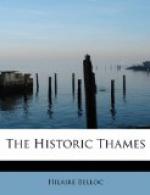In another category, possessing a different type of communal life, already thinking of themselves as towns, we should have Cricklade, Lechlade, Abingdon, and Kingston among the smaller, though probably possessing a population not much larger than that of the larger villages; while of considerable centres there were but three: Reading the smallest, almost a town, but one upon which we have no true or sufficient data; Wallingford the largest, with the population of a flourishing county town in our own days, and Oxford, a place which, though in worse repair, ran Wallingford close.
Henley affords an interesting study. At the time of the Conquest, Bensington was no longer, Henley not yet, a borough. To trace the growth of Henley is especially engrossing, because it is one of the very rare examples of a process which earlier generations of historians, and notably the popular historians like Freeman and the Rev. Mr Green, took to be a common feature in the story of this island. They were wrong, of course, and they have been widely and deservedly ridiculed for imagining that the greater part of our English boroughs grew up since the barbarian invasions upon waste places. On the contrary most of our towns grew up upon Roman and pre-Roman foundations, and are continuous with the pre-historic past. But Henley forms a very interesting exception.
It was a hamlet which went with the manor of Bensington, and that point alone is instructive, for it points to the insignificance of the place. When the lords of Bensington went hunting up on Chiltern they found on the far side of the hill, it may be presumed, a little clearing near the river. This was all that Henley was, and it is probable that even the church of the place was not built until quite late in the Christian period; there is at any rate an old tradition that Aldeburgh is the mother of Henley, and it is imagined by those who wrote monographs upon the locality that this tradition points to the church of Aldeburgh as the mother church of what was at first a chapel upon the riverside.
When we first hear of Henley it is already called a town, and the date of this is the first year of King John, 1199.
It must be remembered that the river had been developed and changed in that first century of orderly government under the Normans. Indeed one of the reforms which the aristocracy made much of in their revolt, and which is granted in Magna Charta, is the destruction of the King’s weirs upon the Thames. But the weirs cannot have been permanently destroyed; though the public rights over the river were curtailed by Magna Charta, the system of regulation was founded and endured. It is probably this improvement on the great highway which led to the growth of Henley, and when Reading Minster had become the great thing it was late in the twelfth century, Henley must have felt the effect, for it would have afforded the nearest convenient stage down the river from the new and wealthy




